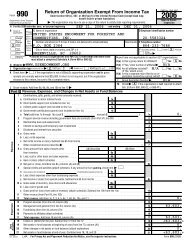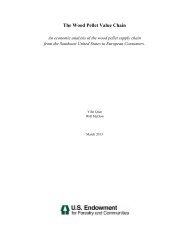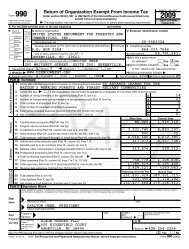The State and Future of U.S. Forestry and the Forest Industry (May ...
The State and Future of U.S. Forestry and the Forest Industry (May ...
The State and Future of U.S. Forestry and the Forest Industry (May ...
You also want an ePaper? Increase the reach of your titles
YUMPU automatically turns print PDFs into web optimized ePapers that Google loves.
Today, about 10 percent <strong>of</strong> <strong>the</strong> world’s forests are certified by one certification system or ano<strong>the</strong>r as sustainablymanaged. However, 70 percent <strong>of</strong> <strong>the</strong>se certified forests occur in only five countries—Canada, <strong>the</strong> U.S., Russia,Finl<strong>and</strong>, <strong>and</strong> Sweden.13Issues <strong>of</strong> concern about <strong>the</strong> stability <strong>of</strong> this link include a growing recognition that, ra<strong>the</strong>r than actual certification<strong>of</strong> a sustainably managed resource, <strong>the</strong> current systems merely represent a process for continued improvement<strong>of</strong> management practices. Finally, despite 20 years <strong>of</strong> experience, <strong>the</strong>re is still little quantified <strong>and</strong> widespreadevidence that certification provides producers any economic benefits in <strong>the</strong> broader marketplace.Logging WorkforceBased upon available economic <strong>and</strong> production data, <strong>the</strong> logging workforce may be <strong>the</strong> weakest link in <strong>the</strong>supply chain today. Logging capacity has been reduced by 25 percent just since 2009. <strong>The</strong> reasons are many <strong>and</strong>significant. Operating costs have soared with increased fuel, parts, <strong>and</strong> equipment costs (<strong>the</strong> cost <strong>of</strong> new loggingequipment has risen 50 percent in <strong>the</strong> last decade). Due to <strong>the</strong> increased expense <strong>of</strong> new equipment, <strong>the</strong> lack <strong>of</strong>long-term contracts <strong>and</strong> o<strong>the</strong>r factors, financing has been harder to secure. Logging markets contracted during <strong>the</strong>recession as l<strong>and</strong>owners deferred harvests due to low stumpage rates <strong>and</strong> as mills were shuttered. <strong>The</strong>se factors<strong>and</strong> more have led to squeezing <strong>of</strong> rates for <strong>the</strong>ir employees, such that 71 percent <strong>of</strong> U.S. logging companiesreport difficulty in attracting new employees (Timber Harvesting magazine, 2013). In 2010, 51 percent <strong>of</strong> loggingcompanies reported a loss or were simply breaking even.Essentially, one hundred percent <strong>of</strong> <strong>the</strong> logging workforce is employed by small, independent logging companies.<strong>The</strong>se companies are family owned, with <strong>the</strong> median age <strong>of</strong> employees having risen to 54 years <strong>of</strong> age.Considerable evidence suggests that, over <strong>the</strong> last decade, this link has been economically squeezed between forestowners <strong>and</strong> manufacturers, jeopardizing <strong>the</strong> entire chain.Manufacturing WorkforceDuring <strong>the</strong> recent recession, <strong>the</strong> manufacturing workforce shrank along with manufacturing capacity. <strong>The</strong> ability<strong>of</strong> <strong>the</strong> industry to respond to increased product dem<strong>and</strong> will be a workforce challenge, as well as a mill capacitychallenge. Manufacturers will find it difficult to find new workers for highly <strong>and</strong> moderately skilled positions dueto <strong>the</strong> aging nature <strong>of</strong> <strong>the</strong> forest products manufacturing work force, as well as competition from o<strong>the</strong>r industries<strong>and</strong> employers who are <strong>of</strong>fering more attractive career opportunities, <strong>and</strong>/or richer compensation packages.One area <strong>of</strong> particular concern is <strong>the</strong> training capacity within <strong>the</strong> industry. Without an organized effort to supporttop-to-bottom training programs, <strong>the</strong>re will be increased unemployment despite high-skilled positions remainingunfilled due to a lack <strong>of</strong> well-trained workers. This gap could become even more problematic if forest certificationsystems move to accelerate <strong>the</strong> emerging trend <strong>of</strong> including labor st<strong>and</strong>ards in <strong>the</strong> certification process.Measures <strong>of</strong> SuccessGeneral measures <strong>of</strong> success can be defined in three broad areas. First are indicators <strong>of</strong> economic success inwhich every link in <strong>the</strong> supply chain is operating in an economically sustainable fashion. Second is evidence <strong>of</strong>pr<strong>of</strong>it margins, with pr<strong>of</strong>it margins commensurate in each link <strong>of</strong> <strong>the</strong> supply chain. Third is evidence <strong>of</strong> adequatetraining systems, showing that such systems are available to allow an increased number <strong>of</strong> new employees enteringsufficient to meet <strong>the</strong> needs <strong>of</strong> each link in <strong>the</strong> supply chain.Action Items—General <strong>The</strong>mesImproving <strong>the</strong> health <strong>and</strong> integrity <strong>of</strong> <strong>the</strong> current supply chain in <strong>the</strong> U.S. manufacturing will require three broadcategories <strong>of</strong> activities: (1) changes to <strong>the</strong> financial incentives that each link in <strong>the</strong> supply chain currently enjoysto streng<strong>the</strong>n <strong>the</strong> health <strong>of</strong> <strong>the</strong> entire chain; (2) expansion <strong>of</strong> forest certification programs to serve exp<strong>and</strong>ingmarkets; <strong>and</strong> (3) increased training programs to address skilled workforce shortages.Action Items—SpecificsEach <strong>of</strong> <strong>the</strong> broad action areas listed above will require detailed action plans <strong>and</strong> budget outlays. Some <strong>of</strong> <strong>the</strong> keyactions should include <strong>the</strong> following.





